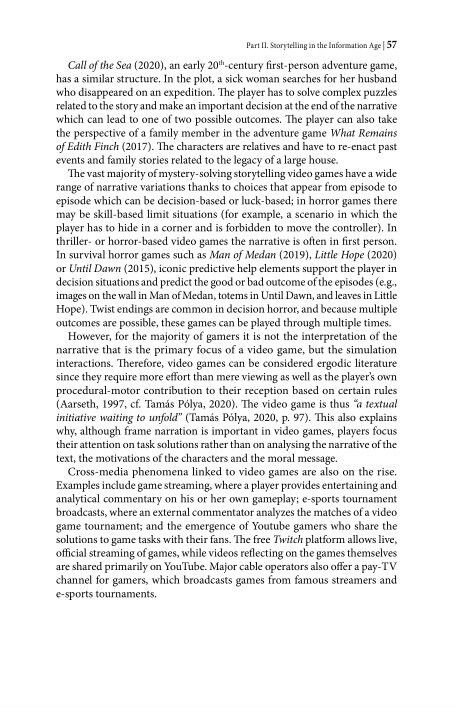
Page 58 [58]

OCR
Part II. Storytelling in the Information Age [ 57 Call of the Sea (2020), an early 209-century first-person adventure game, has a similar structure. In the plot, a sick woman searches for her husband who disappeared on an expedition. The player has to solve complex puzzles related to the story and make an important decision at the end of the narrative which can lead to one of two possible outcomes. The player can also take the perspective of a family member in the adventure game What Remains of Edith Finch (2017). The characters are relatives and have to re-enact past events and family stories related to the legacy of a large house. The vast majority of mystery-solving storytelling video games have a wide range of narrative variations thanks to choices that appear from episode to episode which can be decision-based or luck-based; in horror games there may be skill-based limit situations (for example, a scenario in which the player has to hide in a corner and is forbidden to move the controller). In thriller- or horror-based video games the narrative is often in first person. In survival horror games such as Man of Medan (2019), Little Hope (2020) or Until Dawn (2015), iconic predictive help elements support the player in decision situations and predict the good or bad outcome of the episodes (e.g., images on the wall in Man of Medan, totems in Until Dawn, and leaves in Little Hope). Twist endings are common in decision horror, and because multiple outcomes are possible, these games can be played through multiple times. However, for the majority of gamers it is not the interpretation of the narrative that is the primary focus of a video game, but the simulation interactions. Therefore, video games can be considered ergodic literature since they require more effort than mere viewing as well as the player’s own procedural-motor contribution to their reception based on certain rules (Aarseth, 1997, cf. Tamas Polya, 2020). The video game is thus “a textual initiative waiting to unfold” (Tamas Polya, 2020, p. 97). This also explains why, although frame narration is important in video games, players focus their attention on task solutions rather than on analysing the narrative of the text, the motivations of the characters and the moral message. Cross-media phenomena linked to video games are also on the rise. Examples include game streaming, where a player provides entertaining and analytical commentary on his or her own gameplay; e-sports tournament broadcasts, where an external commentator analyzes the matches of a video game tournament; and the emergence of Youtube gamers who share the solutions to game tasks with their fans. The free Twitch platform allows live, official streaming of games, while videos reflecting on the games themselves are shared primarily on YouTube. Major cable operators also offer a pay-TV channel for gamers, which broadcasts games from famous streamers and e-sports tournaments.
structurelles
Custom
Image Metadata
- Largeur de l'image
- 1831 px
- Hauteur de l'image
- 2835 px
- Résolution de l'image
- 300 px/inch
- Taille du fichier d'origine
- 1.31 MB
- Lien permanent vers jpg
- 022_000040/0057.jpg
- Lien permanent vers OCR
- 022_000040/0057.ocr
